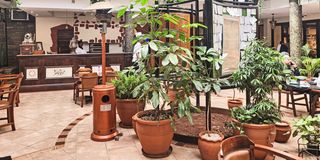Premium
Enjoying a Swahili breakfast at the Sarova Stanley Hotel

Swahili Breakfast at the Sarova Stanley Hotel.
‘I hope you’re not going to have your usual bacon and eggs,’ Lut said with a laugh.
‘No, I’m here for the Swahili breakfast, and I’m looking forward to it!’
‘Here’ was the Sarova Stanley Hotel – a very special place with lots of history and a hotel that celebrates its history in its furnishings, its many photographs on its walls, and its style.
Founded in 1902, it is the oldest hotel in Nairobi, and it used to be at the very centre of the city’s life. An impressive number of famous people have stayed there, among them Theodore Roosevelt, President of the United States; the Emperor of Japan; the novelist Ernest Hemingway; Prince Edward, Duke of Windsor; Sir Winston Churchill, perhaps the best-known and best-respected British Prime Minister.
My first visit there was in the autumn of 1967, to have a coffee in the Thorn Tree Café. If it could speak, the Thorn Tree could tell some good stories. In my first years in Kenya, the actual thorn tree growing in its centre was a kind of post-office, or you could say it was acting as Facebook or WhatsApp do today. People, mainly young European tourists, would pin their messages on the tree. ‘Fred, I will be back right here on Monday, and I hope to see you for a sundowner at 6 o’clock.’ ‘Muriel, it was so good to meet you. I will write when I am back in New York.’ That sort of thing. There’s no tree there now; Isaac, the restaurant manager, told me that the last replacement refused to grow. A message board is still there, but the many notices pinned on it are now rather like the entries you get in a hotel’s guestbook.
I’ve had a number of Swahili meals when at the Coast. Those that are put on for visitors to try can be an exotic spread – dishes flavoured with cloves, ginger, pepper, chilli and coconut. They are dishes that have been influenced by many cultures: African, Arab, Indian and European. Eating from such a spread can provoke a learning about the long history of the East African coastal strip. The name ‘biryani’ – the spice-flavoured rice dish – is Persian; ‘curry’ is from the Tamil word 'kari'; ‘ugali’ is, as you know, Swahili; ‘pizza’ is Italian.
I was intrigued to find out what kind of spread the Stanley would put on for the breakfast. A breakfast at the Coast could be as simple as having mahamri – mandazi cooked with milk – and a cup of sweetened and milky tea. But there was nothing simple about the Stanley Swahili breakfast. I reckon there must have been more than 20 dishes to choose from. You could spend almost 15 minutes just walking round the heated chafing dishes to work out what was on offer.
Let me tell you about my choices. Being a potato rather than a rice man, my base was kiazi kurai (pack potatoes cut into pieces, boiled, then deep fried in a crunchy batter, flavoured with lemon). It is a typical street food that is on sale at almost every corner in Mombasa. I’m very fond of coconut. So, I chose the kuku wa kupaka (chicken in coconut cream). I also added some Indian bhajia with their finely chopped vegetables and gentle spices.
Lut enjoyed sautéed mchicha (amaranth leaves), viazi tamu (sweet potatoes), mbaazi wa mnazi (pigeon peas and coconut. To finish off, we shared some skewers of small fruit – cubes of melon, blackberries, Cape gooseberries and blueberries. For drinks, I enjoyed a glass of tamarind juice, followed by a hot coffee with a mahamri. Then we discovered the coconuts with straws for drinking their water – a very refreshing end to a splendid meal.
The celebration of Swahili culture was not just in the offerings of food and drink. There was a strip of kanga-style cloth across each table, and some of the waiters wore Swahili-patterned tunics. It would also have been nice to have had Swahili music playing. The large and muted TV was showing football and seemed out of place in such a setting. Fortunately, it was tucked away in a corner.
In the old days, the Thorn Tree Café was open to the street, but now it is screened. It is not as closed off as is Stanley’s old rival, the Norfolk Hotel, which has almost separated itself off from city life. Its Delamere Terrace used to be a popular meeting place, but not now. In contrast, because of the low screen of attractive stained glass and potted plants of the Thorn Tree and the low buzz of passing traffic, you don’t feel cut off. It is not just a hotel for tourists; it is still a meeting place for city people.
John Fox is Chairman of iDC Email: [email protected]





